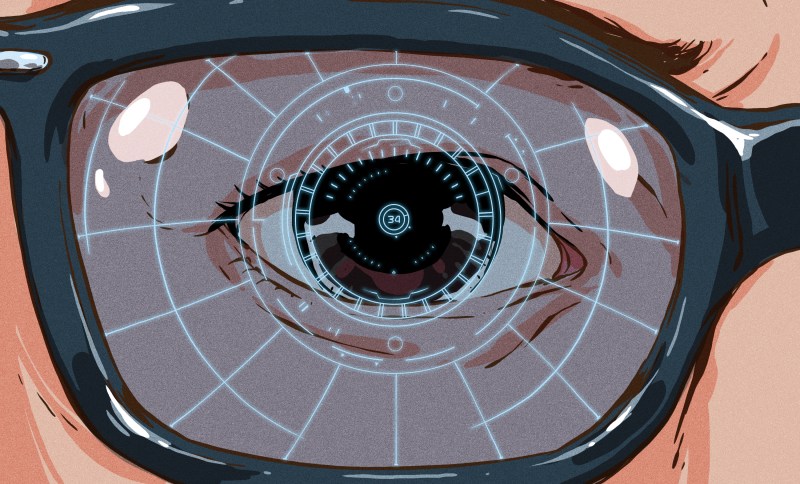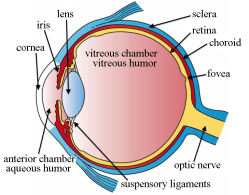Tech in Plain Sight: Eyeglasses

Glasses wearers, try a little experiment. Take off your glasses and look at this page or, at least, at something you can’t see well without your glasses. Now imagine if you lived in a time where there was nothing to be done about your vision. If you wear contacts or you have good vision — perhaps you had surgery — then congratulations. But for most of us, vision changes with age are a fact of life. Even many young people need glasses or some other intervention to get good eyesight. At first glance, you might think eyeglasses are an obvious invention, but it turns out we didn’t get real glasses for quite some time and modern glasses are truly a piece of high tech that hides — quite literally — right in front of your face.
What’s Wrong?

First, light enters the eye through the cornea, a clear dome in the front. The light then passes through the pupil, the black dot in the center. The colored part of your eye, the iris, controls how much light goes through, sort of like a lens aperture on a camera.
Inside your eye is a transparent lens structure that focuses the light rays. They pass through a jelly-like substance that keeps your eye round and the focal point is at the retina which contains light-sensitive nerves. Unlike a camera, the retina isn’t flat like a piece of film but curves. However, like any camera, the image is now upside down, but your brain doesn’t mind. As an aside, though, if you flip your vision around so it is really upside down, your brain will eventually dutifully flip it back for you as you can see in the video below.
When Things Go Wrong
People generally think of vision problems as being far-sighted or near-sighted. That is, fuzzy objects up close or far away, respectively. However, you can also have astigmatism which just causes general fuzziness and what we think of as far-sight can be caused by two distinct problems with your eye.
Astigmatism is when the shape of the cornea is not perfect, so light coming in can wind up at more than one spot on the retina. If you have astigmatism, everything looks fuzzy and something like an LED will appear to be more than one LED from a distance.
Hyperopia, a type of far-sightedness, and myopia or near-sightedness happen when the length of the eye is not correct or the lens system has an incorrect focal length. For hyperopia, the image focuses behind the retina and myopia has the focus ahead of the retina. The other cause of far-sightedness is presbyopia which is where the center of the eye’s lens hardens with age. The end effect is the same as hyperopia and it is why as we get older we can’t read fine print.
The Optics

You can think of a lens as two prisms. For a concave lens, the two prisms meet at their tips. For a convex lens, they meet at the base. If you aren’t used to thinking of a lens as a pair of prisms, you might enjoy the video below.
As the video mentions, light sort of bends around the base of a prism. Ok, it doesn’t really bend, but that’s a good way to think about it. So as light goes into a concave lens, it tends to spread out but through a convex lens it tends to converge on a spot some distance from the lens — the focal length.
That’s true, at least, of a spherical lens. You can also have a cylindrical lens that focuses to a line instead of a point. If you need both types of lenses at one time, you need to find a toric lens.
By making the image spread out or converge before it hits your eye, glasses can correct for common vision problems. With a cylindrical lens, you can fix astigmatism, too. Obviously, if you have multiple problems, you’ll need a toric lens.
Ancient History
While it seems simple to create a lens and hang it in front of your face, there are two parts to that. First, you have to know how to make a lens or find one that occurs naturally. Next, you have to have the idea of how to suspend them in front of your eyes.
Glass has been around for at least 4,000 years, but not high-quality glass. There are quite a few claims of ancient lenses used to either magnify or focus the sun to start fires, but they are either natural stones or very poor quality glass, and there is debate if they would have worked for either case.
The Romans became good at making glass in the first century and realized that a bean-shaped piece of glass — a convex lens — would make objects appear bigger. The word lens comes from the Latin word for lentil.
However, history is a little vague about the use of lenses to help people see. It looks like an Arab created reading stones in the 900s and they became relatively common by the year 1,000. If you’ve ever used one of those solid plastic bars that you put on something small like a phone book to make the text bigger, that’s the same idea. Of course, the material would be glass or crystal.
Glasses Arrive

It would be the 13th century before we started seeing what we would think of as simple glasses. Early glasses in Italy were crude blown glass held with a frame of leather or wood. Until around 1600, though, you’d hold the glasses in your hand or push them down on your nose. The early glasses were all convex, although by the 1400s concave lenses were known, although it would be 1604 before Kepler would explain why they all worked.
Around 1600 someone worked out how to clip glasses to your ears although this is often attributed to Edward Scarlett in 1727. As you can see from the adjoining El Greco painting, though, some people had this style of eyewear as early as 1600.
Earpieces were a game-changer although you can still find the occasional monocle or pince-nez. There was still one major problem: glasses strong enough to help you see things close up made a mess of things that were far away.
Benjamin Franklin, who had poor vision, invented the bifocal where each lens had a near part and a far part. There have been some claims that Franklin didn’t invent them but, rather, popularized them. It would be 1825 before astronomer George Airy would figure out how to correct astigmatism.
Modern Glasses
Like everything else, glasses went high-tech at an accelerating rate through the 20th century. Frames are now made with memory alloys that return to their original shape. Lenses made of special material are lightweight and durable. They also can have coatings to reduce glare, block UV light, or turn dark in bright lights.
One of the biggest improvements stemmed from the bifocal. First, there were trifocals with three lenses. However, now sophisticated lens grinding techniques allow progressive lenses where the lens has different properties that vary continuously across the lens.
Computers can grind lenses in classic shapes or create aspheric or atoric lenses that can correct vision in more sophisticated ways than a normal lens. You can see a common eyeglass lab’s process in the video below.
RX and Other Solutions
It helps to know Latin if you want to read an eyeglass prescription. You’ll see numbers under the heading OS and OD and rarely OU0. The O is for oculus (eye), the S is for sinister (left) and D is for dextrus (right). The U means both eyes.
If you don’t have astigmatism, you’ll see diopter numbers for each eye. This is the amount of focusing change you need and lower numbers are better (a diopter is the reciprocal of the focal length in meters). A negative number means you are near-sighted and a positive means far-sighted. A zero would mean you didn’t need glasses, so you probably won’t see that unless you have only one bad eye.
For astigmatism, you’ll see three numbers. The first is the diopter, the same as above and is referred to as the SPHERE. The next number is a measure in diopters of how much astigmatism requires correction (CYLINDER). The final number is the axis between 0 and 180 degrees which gives you the rotation of the correction.
If you need bifocals or progressives, you’ll see an ADD number as well. This is the additional diopters needed for a bifocal. In the case of a progressive lens, of course, there will be a continuous slope of magnification across the lens. This number is nearly always the same for both eyes, but if one of them has PAL next to it, then it should be used for both eyes with progressive lenses and the other number is for proper bifocals. You’ll sometimes see a PD or pupillary distance. That’s for setting up the frames but doesn’t affect the optics.
You’d think with contacts and laser surgery for vision correction eyeglasses wouldn’t be very common. But they are. Why not? They are relatively cheap, don’t take much in the way of maintenance, and they work well. While the tech that goes into them today requires computer-controlled grinding machines and lots of math, even the simple glasses available centuries ago must have seemed like a miracle to people who could no longer read or see things clearly.
It is possible to build your own lenses, but it is hard to match the quality of a real lab. Glasses used to be nerdy, but now they are fashionable. If you want to look like a nerd again and you need progressives, maybe you’ll prefer a pair of these.
Post a Comment